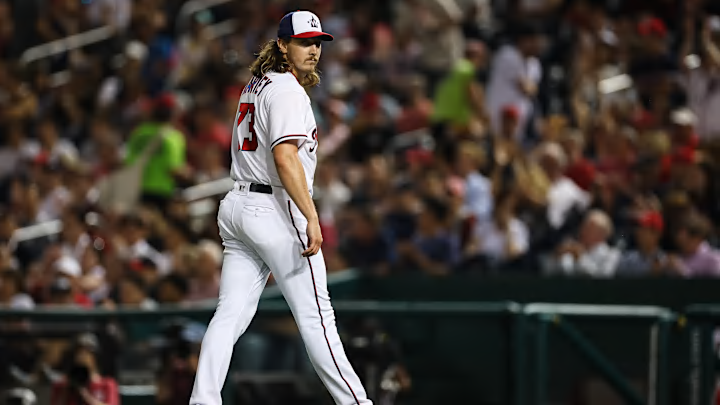The Nationals are one of the relatively few teams this year who will be obvious sellers at the August 1st trade deadline. There is no question they will be shopping Jeimer Candelario and will certainly be listening to offers on Lane Thomas as well. Outside of a miracle Patrick Corbin trade (a guy can dream!), the Nats don’t have any starting pitchers that are likely to be moved. However, despite overall poor bullpen performance, they do have some intriguing relievers that could improve just about any contending team down the stretch. The issue now becomes: which relievers should the Nationals try and trade?
The real question when trying to determine who should be traded is: will the player be a part of the next great Nats team? The Nationals timeline for contention has the slightest chance to be open in the 2025 season, with more realistic targets of 2026 and 2027. This means that any player who won't be under team control or still producing at a high level by 2026 is basically just a placeholder, waiting for a more talented or cheaper player to take over their position when the Nationals are ready to contend again. Others may disagree, but it matters very little to me whether the Nationals win 65 or 68 games this year. I care much more about games to be won in 2025.
I contend that none of the current Nationals relievers will be part of the next great Nats teams. Therefore, any reliever that has value right now should be traded at this year’s deadline.
Bullpen turnover is incredibly high, as this Fangraphs article on the topic points out, as overall bullpen turnover is primarily due to volatility of relief pitcher performance year to year. That volatility is driven by two main factors: small sample sizes and injury risk.
Relievers inherently work in small sample sizes, compiling a small fraction of innings pitched each year when compared to starting pitchers. Small sample sizes make forecasting future performance very difficult. A few poor outings can tank a reliever’s statistics for an entire year while some batted ball luck in another year can make his performance appear dominant. There have been some consistently dominant relievers in the past such as Mariano Rivera, Trevor Hoffman, and Rollie Fingers, but beyond the best of the best, most relief pitchers struggle to perform consistently over the course of a long MLB career. Lights out relievers in one year can end up getting cut the next year.
Injury risk for relief pitchers, like all pitchers, is very high. However, relievers generally throw harder than starters and it has been shown that pitchers who throw at a higher velocity face a higher risk of injury than those that throw slower. Each year the Nationals and every other team cycle through a seemingly endless carousel of relief pitchers, all throwing extremely hard and too many times being placed on the IL with an arm injury so another hard throwing reliever can be called up in his place.
For these reasons, relief pitchers’ careers often involve extreme highs and lows. Just look at the history of the Nats relievers most likely to be traded at this year’s deadline:
- Kyle Finnegan: Released by the A’s in 2019, signed by the Nats thereafter and didn’t make his MLB debut until 2020 at age 28
- Hunter Harvey: Drafted by the Orioles in 2013, picked up on waivers by the Giants in 2021, picked up on waiver by the Nationals in 2022
- Carl Edwards Jr.: Drafted by the Rangers, traded to the Cubs and pitched for them until 2018, then made appearances with the Mariners, Braves, Blue Jays, White Sox all before being picked up by the Nats before the 2022 season
Each one of these relievers has at one point been released or DFA’d by their previous teams but now are potentially coveted by contending teams looking to bolster their bullpens. It is almost impossible to know what type of players these three pitchers will be in 2025, but chances are they will not be performing at their current levels. The Nats need to listen to any and all offers for pitchers this trade deadline, no relief pitcher should be off limits.
I, for one, am willing to struggle through a few additional ugly games this September with an even worse bullpen if it means a few additional prospects get added to the pipeline. Bullpens are fickle, able to be torn down and rebuilt in a single offseason. They are not something that the core of a team can be built around. While it might make the remainder of this season tougher to watch for Nationals fans, trading this current crop of relievers could lead to more consistent teams in the near future.
